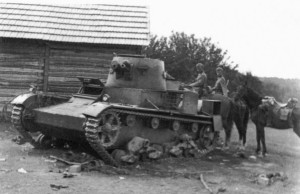Tank Cemetery: Armored Battle in Shanghai
- By Peter Harmsen
- 16 February, 2013
- 61 Comments

By Simon Q from United Kingdom (Vickers Armstrongs Mark E, Type B Uploaded by tm) [CC-BY-2.0 (http://creativecommons.org/licenses/by/2.0)], via Wikimedia Commons
The Chinese commanders sent the tanks against nearly impenetrable Japanese positions, which were protected not just by their own guns, but also by the powerful naval artillery of the Japanese Third Fleet anchored just a few hundred yards away in Shanghai’s HuangpuRiver.
At the end of the day, the narrow streets of Shanghai were a horrible place to wage a tank battle, as the Japanese side also came to realize. The Chinese tank crews were further disadvantaged by the lack of coordination with the infantry. Ultimately, the Vickers failed because of weak tactics, not because of any technical flaws per se.
The name plate of one of the Vickers captured by the Japanese tells its own story about China’s first attempts to build a tank arm: “Vickers-Armstrongs Ltd. Light Tank Mk E Manufactured for the National Government of China by Vickers-Armstrongs Ltd Elswick Works England. Sole Agents for China The Jardine Engineering Corporation Ltd. No VAE 807. Date Oct – 1934.”
China had bought about 20 Vickers Mark E tanks in the years prior to the battle of Shanghai. The Type A had two turrets, but the Chinese opted for Type B, which featured a single turret equipped with a short-barreled 47mm gun and a machinegun. It was part of an ambitious weapons procurement program initiated by a Chinese government convinced that war with Japan would come sooner or later.

A destroyed Polish Vickers tank during the German invasion in 1939
Tank manufacturer Vickers had originally designed the Mark E with the British army in mind, but the top brass rejected it. However, what had started as a domestic failure turned into a modest export success story. Countries as diverse as Bulgaria, Poland and Siam (present-day Thailand) placed orders with Vickers.
By the late 1930s, the Vickers Mark E was the world’s most common tank design after the French-built Renault FT. Its baptism of fire was when Bolivia deployed it in its Chaco War with Paraguay in 1933. Its use was mainly unsuccessful, partly due to the harsh terrain, but also because the officers, like most officers at the time, didn’t really understand how to use armor properly.
The Vickers Mark E was also a common feature of the early battles of World War II, although it usually turned up on the losing side. It was deployed by the Polish army during the German and Soviet invasion in September 1939 and a few months later by the Finnish side in the winter war with the Russians.
Probably the Vickers Mark E’s most lasting legacy was in the Soviet Union. The Russians bought a small number from the British manufacturer and used it as the basis for their own line of tanks, the T-26, of which there would eventually be 12,000.

 Copyright © 2025
Copyright © 2025
Leave a Reply